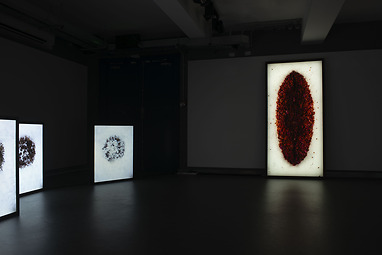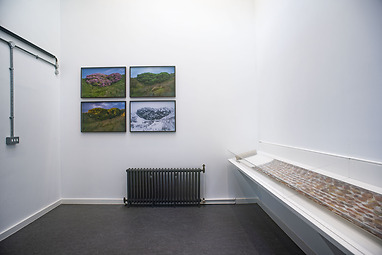
Autumn Winter Spring Summer is a year-long, personal appreciation of one Rhododendron ponticum’s seasonal materials. Interestingly, the outward-facing study of plant specimen led to the inward-facing study of the artist’s own position in postcolonial and patriarchal societies. The rhododendrons the most iconic plants introduced to the UK by colonial botanists in the mid-18th century. Once the subject of ‘rhodo-craze’ during the Victorian era, the rhododendrons, particularly the hybrid species Rhododendron ponticum, are often seen as non-native invasive species in contemporary Britain. They are referred to as an ‘unwelcome alien’, targeted for removal with violent methods including cutting down, poisoning, and burning. Such hierarchy in which the non-native is regarded as secondary to the native suggests that politics might be at play within the authority of science.
‘Can migrant species such as the Rhododendron ponticum be understood in other ways, particularly by a migrant person?’ With this question, the British-Chinese artist Yan Wang Preston began to work with a tiny Rhododendron ponticum shrub in the autumn of 2020. Having collected the plant’s materials in different seasons, Wang Preston allowed herself to subjectively respond to the specimen, giving room for intuition, intervention, and play. She borrowed methods of botanical studies and conservation management while tracing back to her own history as a trained medical doctor in China. The long, laborious, and ritualistic processes in the land and in her studio aligned her practice towards western land and conceptual art, yet eastern meditation and self-reflection are at the core. Photography was employed not as observation or documentation, but as performance and embodiment.

For Autumn – Leaves, Wang Preston collected all the red leaves produced by the plant during the whole autumn of 2020. Having touched them one by one, she laid them down on her studio floor before photographing them. The resulting work is a 6-metre hand scroll, produced to the highest quality by some of the best craftsmen in Shanghai. In the winter, she collected all the seed capsules from the same plant before setting them on fire, making a reference to the violent removal of the rhododendrons while celebrating the plant’s resilience. This piece, Winter – Seed Capsules, is presented as a set of 11 spectacular Duratrans lightboxes. In the winter, she then dissected all the 75 aborted flower buds from the same plant before photographing the aftermath of such a problematic method of scientific study. This piece, Winter – Bud Blast, has become an artist book and an audio-visual installation. Finally, when the spring and summer came, she collected all the flowers, again from the same plant, before sculpting them into the shape of a vulva. This piece, Spring Summer – Flowers, is produced as a double-layered tension fabric lightbox, glowing in the dark with all its femininity.
‘I started by cutting the world open. I ended by cutting myself open.’ This finishing line in her book Winter – Bud Blast sums up Yan Wang Preston’s learning in questioning the authority of western science while finally admitting her own position as a woman in the patriarchal societies of both China and Britain. In this cyclical series, the British landscape is seen anew with its multicultural plants and people; meanwhile, the reality that ‘nature’ is cultured and gendered is made plain. The making of Autumn Winter Spring Summer became a milestone for the artist. The feminist stance has never been made so clear in her work. Meanwhile, for the first time she produced sculptural objects which contain layers of meaning bound up in her choices around multimedia construction and transcultural materials.